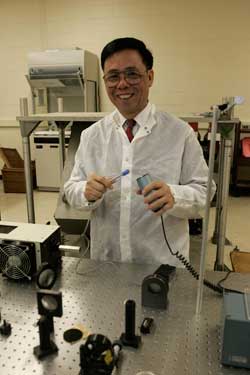Research licensing revenues hit new high
When fiscal year 2011 closes on June 30, revenues from licensing agreements for Temple-developed technologies will surpass the $1 million mark for the first time in the university’s history, according to the Office of Technology Development and Commercialization.
Revenues for fiscal year 2011 from tech transfer projects are estimated to be $1,237,954, more than three times the $380,000 the university received in fiscal year 2010, according to Stephen Nappi, director of technology development and commercialization.
In addition, university researchers will receive more than $450,000 in licensing royalties for technologies they’ve developed, led by Physics Professor and Chair Rongjia Tao, who will receive more than $130,000.
Nappi attributes the revenue increase to several factors, including the establishment of new licensing agreements with outside companies, effective management of existing commercialization agreements, increases in patenting and licensing activity, and two technologies developed by Tao that are starting to attract investment.
“We signed five new licensing deals last year and we have the potential to have signed seven or more new licensing deals by the end of this fiscal year — and that includes new spin-out companies,” said Nappi. “Those deals last year and the new ones we’re putting into place this year open up new lines of revenue. So the more licensing deals we can get out there, the more lines of revenue for the university.”
Nappi said his office expects to have more than 40 new inventions disclosed to the office by the end of the fiscal year — a new high. Over the past five years, the university has averaged 30 invention submissions per year.
While licensing agreements can run for the life of a patent — 20 years from the date of application — they typically will range between eight to 12 years, said Nappi. Commercialization revenues generated from those agreements are then split 60/40 between Temple and the faculty researcher. Of the 60 percent received by the university, 20 percent goes to the general fund, 20 percent goes to the Office of Technology Development and Commercialization, 14 percent to the researcher’s department or research unit and 6 percent to the researcher’s college or school.
The projected revenues for fiscal year 2011 will see approximately $468,000 distributed among Temple researchers, $234,000 to the office of technology development and commercialization, $164,000 to the researchers’ departments and $70,000 to the researchers’ schools and colleges, said Nappi.
Licensing agreements for fuel injection and crude oil viscosity technologies will bring Tao the largest royalties check ever received by a university researcher, $132,254. Other research faculty who will receive significant royalty checks include Reza Fassihi, professor of pharmaceutical sciences in the School of Pharmacy; Daniel Boston, associate professor of restorative dentistry in the Kornberg School of Dentistry; and Frank Chang, professor of biology in the College of Science and Technology. Chang has the university’s longest-running licensing agreement, dating back to January 1993.
“Temple’s research enterprise continues to produce technologies with outstanding commercial potential. These milestones related to our commercialization enterprise represent the building of momentum,” said Kenneth Blank, senior vice provost for research and graduate studies. “We expect a significant increase in the development of new technologies by our faculty that will be licensed to startup and established companies. This process will benefit the public and provide new revenue opportunities.”
Although the totals won’t be finalized until after June 30, the College of Science and Technology and its various departments is projected to receive approximately $199,568 in revenues from the licensing agreements, followed by the School of Pharmacy ($15,105), the School of Medicine ($13,861) and the Kornberg School of Dentistry ($5,324).
“When the revenues from our licensing agreements come in, it is spread to the schools, colleges and departments with the purpose of stimulating further research,” Nappi said.
Faculty researchers are not the only ones to receive royalties from licensed technology. Post doctoral and graduate students involved in research can be part of a patent and licensed technology, said Nappi. A current post doctoral student and two former graduate students will receive royalties totaling approximately $112,945.
